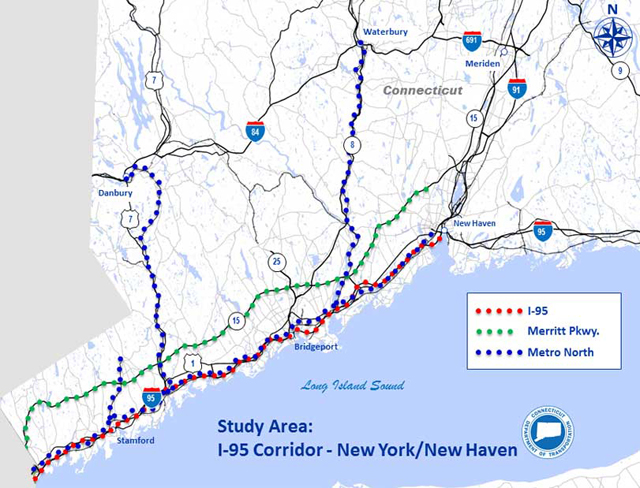The Day (New London, Conn.)
Connecticut DOT to Conduct Study of I-95
Thomas Maziarz, the bureau chief for the DOT's Bureau of Policy and Planning, informed the Southeastern Connecticut Council of Governments of plans for the study at the council's meeting Wednesday in Norwich.
Maziarz said the DOT's new study — which will update a study more than 10 years old — will cover both the western I-95 corridor, from the New York state border to New Haven, and the eastern corridor, from New Haven to the Rhode Island border.

Maziarz said Wednesday that DOT has had discussions with local officials over the past three to four years about their priorities.
"I think we have a good understanding of what the priorities of the region were and knew I-95 was on the top of that in terms of congestion and safety," Maziarz said at the meeting. He added that the DOT understands the I-95/I-395 interchange is a "key problem" in the region.
The stretch of I-95 from the Raymond E. Baldwin Bridge to the Gold Star Memorial Bridge, the area "most in need of improvements," will be the focus for the study of I-95's eastern corridor, he said.
After several serious accidents on a stretch of I-95 between Old Lyme and Waterford at the beginning of this year, local officials intensified calls for improvements to the highway. A special investigation by The Day found that over 19 years of data, East Lyme from Exit 71 to the split with I-395 has the highest number of fatalities and injuries in the state east of the Connecticut River: 745, or about a quarter of the crashes that injured or killed.
In January, DOT spokesman Kevin Nursick attributed the majority of the accidents on that stretch between 2010 and 2014 to "basic, fundamental driver errors." He urged more compliance with existing laws and speed limits. "The first line of defense is to get people to voluntarily cooperate with the rules of the road," he said at the time.
But East Lyme First Selectman Mark Nickerson argued with DOT Commissioner James Redeker at a May meeting of the Southeastern Connecticut Council of Governments that the problem on the road goes beyond distracted driving and ongoing construction. He pointed to the tightening of the highway and hills in the area. Redeker had told the council at the meeting that widening Interstate 95 and improving the interchange with Interstate 395 are the long-term solution to accidents on the highway between Old Lyme and Waterford.
The new study is a component of Gov. Dannel Malloy's 30-year "Let's Go CT" transportation proposal, according to a DOT news release. The study will include the I-95/I-395 interchange, which DOT had looked at separately but was not a part of the earlier, 10-year-old study. The DOT will study whether it can design a safer layout for the interchange and reduce its overall "footprint," among other improvements.
"With the termination of the Route 11 project, we will have a little more flexibility with how we can adjust the alignment of the interchange," Maziarz said.
The Federal Highway Administration had announced in October that it was not moving forward with an environmental impact study on a proposal to extend Route 11.
Maziarz noted that the department has committed to plans, which are already in the design phase, to improve the I-95 interchange with Route 161 in East Lyme.
He said DOT is looking at all interchanges as part of the study. DOT hopes the study will pinpoint, in particular, a way to scale back the Route 32 interchange in New London and modify the design of Route 32 to make the area more pedestrian-friendly. Route 32 in New London was the site of a pedestrian fatality in December 2015.
Maziarz said DOT already has been looking at traffic in the area and having discussions with the city, the Coast Guard Academy and Connecticut College.
"One of the things that we concluded is the existing interchange is a real impediment to the city and the ability to develop the city," he said, comparing it with how the I-84 viaduct divided Hartford.
Maziarz said he estimates the I-95 study will take about 18 months, and then DOT will determine the specific areas to focus its design efforts.
The State Bond Commission has allocated $125,000 for the study of the eastern part of I-95, according to the release. Maziarz said DOT also will pursue federal funds to cover the estimated $400,000 to $500,000 cost of the study.
In addition to I-95, Maziarz said, DOT also wants to fix Route 85 to ease congestion and make it safer for travel. He said the project is even more important, now that the Route 11 proposal has ended.




